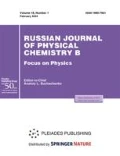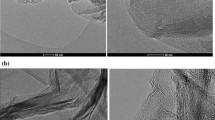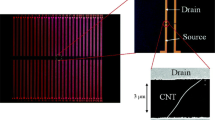Abstract
This work is concerned with reaction paths in the interaction of carbon defect-free nanostructures with different surface curvatures (graphene, tubulenes, and fullerene C60) with atomic and molecular oxygen. The interaction energies of atoms were calculated by the density functional theory method using the basis set of plane waves and the VASP package. The potential surface of reactions with molecular oxygen was studied by the nudged elastic band method. The energy parameters of the reaction (released energy and barrier) strongly depended on the curvature of carbon structure surfaces. The interaction of atomic oxygen in the ground state with the surface of carbon nanostructures is an exothermic reaction. The barrier to the reaction with molecular oxygen (0.5–2.5 eV) decreases as the curvature of nanostructure surfaces increases. The calculation results are in agreement with the experimental data and other ab initio calculations.
Similar content being viewed by others
References
B. S. Haynes, Combust. and Flame 126, 1421 (2001).
Y.-J. Xu and J.-Q. Li, Chem. Phys. Lett. 400, 406 (2004).
A. Montoya, F. Mondragon, and T. N. Truong, J. Phys. Chem. B 106, 4236 (2002).
A. Montoya, T. T. Truong, F. Mandragon, and T. N. Truong, J. Phys. Chem. A 106, 6757 (2001).
T. J. Frankcombe and S. C. Smith, Carbon 42, 2921 (2004).
G. E. Froudakis, A. N. Andriotis, M. Menon, and R. M. Sheetz, Pys. Rev. B 68, 115435–1 (2003).
P. Gianozzi, R. Car, and G. Scoles, J. Chem. Phys. 118, 1003 (2002).
D. Sh. Sabirov, S. L. Khursan, and R. G. Bulgakov, J. Mol. Graphics Modell. 27, 124 (2008).
A. V. Nemukhin, B. L. Grogorenko, I. A. Topol, and S. K. Burt, J. Comput. Chem. 24, 1410 (2003).
D. Heymann, S. M. Bachillo, R. B. Weisman, et al., J. Am. Chem. Soc. 122, 11473 (2000).
S. M. Lee, Y. H. Lee, Y. G. Hwang, J. R. Hahn, and H. Kang, Phys. Rev. Lett. 82, 217 (1999).
P. N. D’yachkov, Carbon Nanotubes (BINOM, Moscow, 2006), p. 30 [in Russian].
H. Ulbricht, G. Moos, and T. Hertel, Surf. Sci. 532–535, 852 (2003).
G. Kresse and D. Joubert, Phys. Rev. B 59, 1758 (1999).
G. Henkelman and H. Jónsson, J. Chem. Phys. 113, 9978 (2000).
K. M. Creegan, J. L. Robbins, W. K. Robbins, et al., J. Am. Chem. Soc. 114, 1103 (1992).
M. Menon and K. R. Subbaswamy, Phys. Rev. Lett. 67, 3487 (1991).
A. V. Eletskii and B. M. Smirnov, Usp. Fiz. Nauk 165, 1009 (1995) [Phys. Usp. 38, 1055 (1995)].
Author information
Authors and Affiliations
Corresponding author
Additional information
Original Russian Text © I.A. Valuev, G.E. Norman, B.R. Shub, 2011, published in Khimicheskaya Fizika, 2011, Vol. 30, No. 1, pp. 82–88.
Rights and permissions
About this article
Cite this article
Valuev, I.A., Norman, G.E. & Shub, B.R. Mechanisms of the oxidation of defect-free surfaces of carbon nanostructures: the influence of surface curvature. Russ. J. Phys. Chem. B 5, 156–162 (2011). https://doi.org/10.1134/S1990793111010131
Received:
Published:
Issue Date:
DOI: https://doi.org/10.1134/S1990793111010131




